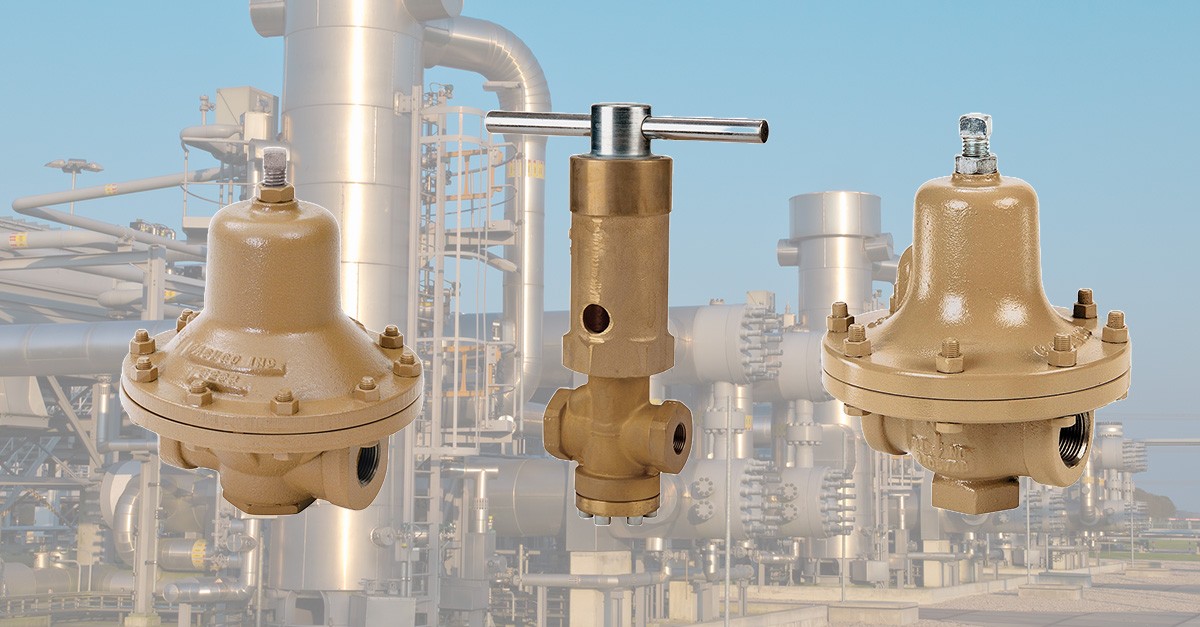
Industrial gas, 19 February
Regulators in gas applications
In gas systems, pressure control is essential to ensure safe and efficient operation. Two key components used for maintaining optimal pressure levels are Pressure Reducing Regulators (PRRs) and Back Pressure Regulators (BPRs). These regulators do not need external signals to operate; they are all self-contained and function autonomously based on system conditions. While both regulate pressure, they serve different functions within a system.
Our range of high-quality pressure regulators from Cashco, includes both pressure reducing regulators and back pressure regulators. Here is an explanation of the different types and their respective purposes and applications.
Types of Pressure Regulators
Pressure regulators are available in different configurations to suit specific applications:
- Spring-Loaded Regulators: Simple and cost-effective, these regulators use a mechanical spring to maintain pressure control, making them ideal for applications with moderate pressure requirements.
- Pressure-Loaded Regulators: Utilize an external pressure source to provide more precise control and stability compared to spring-loaded types.
- Pilot-Operated Regulators: Offer the highest level of precision by using a pilot valve to control the main regulator, suitable for high-flow and high-accuracy applications. Pilot-operated regulators are used where accuracy is critical, and flowrate varies.
Working Principle
- A PRR’s and BPR’s consists of a sensing element (diaphragm or piston), a control spring, and a valve body and work on the force balance principle. The spring force on the diaphragm is balanced against the force of the inlet pressure the plug and outlet pressure on the diaphragm, allowing the valve to modulate and control the pressure. All pressure regulators are proportional control devices only
- PRR’s control the downstream pressure and BPR’s control the Inlet pressure. DPR’s maintain a differential pressure between two systems.
Pressure Reducing Regulators (PRRs)
A Pressure Reducing Regulator is used to reduce a higher inlet pressure to a controlled, stable outlet pressure. These regulators automatically adjust to variations in inlet pressure and flow to maintain a consistent downstream pressure, ensuring safe and reliable system operation.
Applications
- Industrial Gas Supply: Used in manufacturing plants to maintain specific gas or steam pressures for various applications. Gas supply from Cryogenic Liquified gas storage vessels or high-pressure cylinders.
- Medical Gas Systems: Ensures safe delivery of oxygen and other gases to patients.
- Compressed Natural Gas (CNG or LNG) Systems: Regulates pressure from storage tanks to downstream equipment.
- Welding and Cutting Operations: Maintains a steady gas flow for torches and other equipment.
- HVAC and Refrigeration Systems: Regulates refrigerant gas pressures for efficient operation.
Back Pressure Regulators (BPRs)
A Back Pressure Regulator is designed to maintain a set pressure upstream of the device by relieving excess pressure. Instead of controlling downstream pressure like PRRs, BPRs work as a pressure relief mechanism to prevent overpressure conditions. Back pressure regulators is also called pressure sustaining regulators or pressure relief regulators. (*Note: Back pressure regulators are not Coded safety relief valve)
Applications
- Gas Cylinder and Storage Systems: Prevents overpressure by venting excess gas.
- Fuel Gas Systems: Regulates back pressure in fuel supply lines to ensure consistent burner performance.
- Chemical Processing Plants: Maintains precise pressures in reactors and pipelines.
- Test and Calibration Equipment: Ensures accurate control of gas pressure during testing procedures.
- Vacuum Systems: Regulates back pressure in gas evacuation systems.
- Water Recirculation: Maintains a constant pressure in ring main water systems
Differential Pressure Regulators (DPRs)
A Differential Pressure Regulator is used to maintain a constant pressure difference between two points in a system. These regulators are essential in applications where precise pressure balance is necessary to ensure proper system functionality. DPR’s could either be a back pressure or pressure reducing differential pressure regulators, it vary from application to application.
Working Principle
A DPR operates by continuously monitoring the pressure differential between two points. When the pressure difference deviates from the setpoint, the regulator adjusts the flow to restore balance. This ensures stable system operation by compensating for fluctuations in supply or demand.
Applications
- Compressor and Pump Seal Pressure Control: Ensures optimal sealing by maintaining a consistent pressure differential between process and seal gas.
- Filtration Systems: Regulates pressure differentials across filters to optimize performance and longevity.
- Flow Balancing in Process Systems: Maintains stable flow rates in critical industrial processes.
- Cooling and Heating Systems: Ensures balanced pressure in heat exchangers and other thermal control systems.
- Medical and Laboratory Equipment: Used in precision control applications requiring strict pressure differentials.
Conclusion
Both Pressure Reducing Regulators, Back Pressure Regulators, and Differential Pressure Regulators are vital for maintaining pressure control in gas systems. PRRs ensure a stable downstream pressure, BPRs protect upstream systems from overpressure, and DPRs maintain precise pressure differences in critical applications. Additionally, selecting the appropriate regulator type—Spring-Loaded, Pressure-Loaded, or Pilot-Operated—can further enhance system efficiency and performance. Proper selection and maintenance of these regulators contribute to safety, efficiency, and system longevity in gas handling operations.
Find out more about our valve solutions for industrial gas applications here. Feel free to contact us for help finding the right valve for your process. You can also book a meeting directly with one of our product specialists.
 Language
Language Swedish
Swedish English
English